Tran Quoc Pagoda is a majestic and ancient Buddhist temple nestled on an island in Hanoi’s West Lake. Its rich history, serene atmosphere, and stunning architecture make it a must-visit for anyone exploring the city. Tran Quoc Pagoda is more than just a temple; it’s a gateway to Hanoi’s history, beauty, and soul. With its peaceful presence and captivating stories, it promises a journey of discovery and a chance to connect with the city’s vibrant spirit.
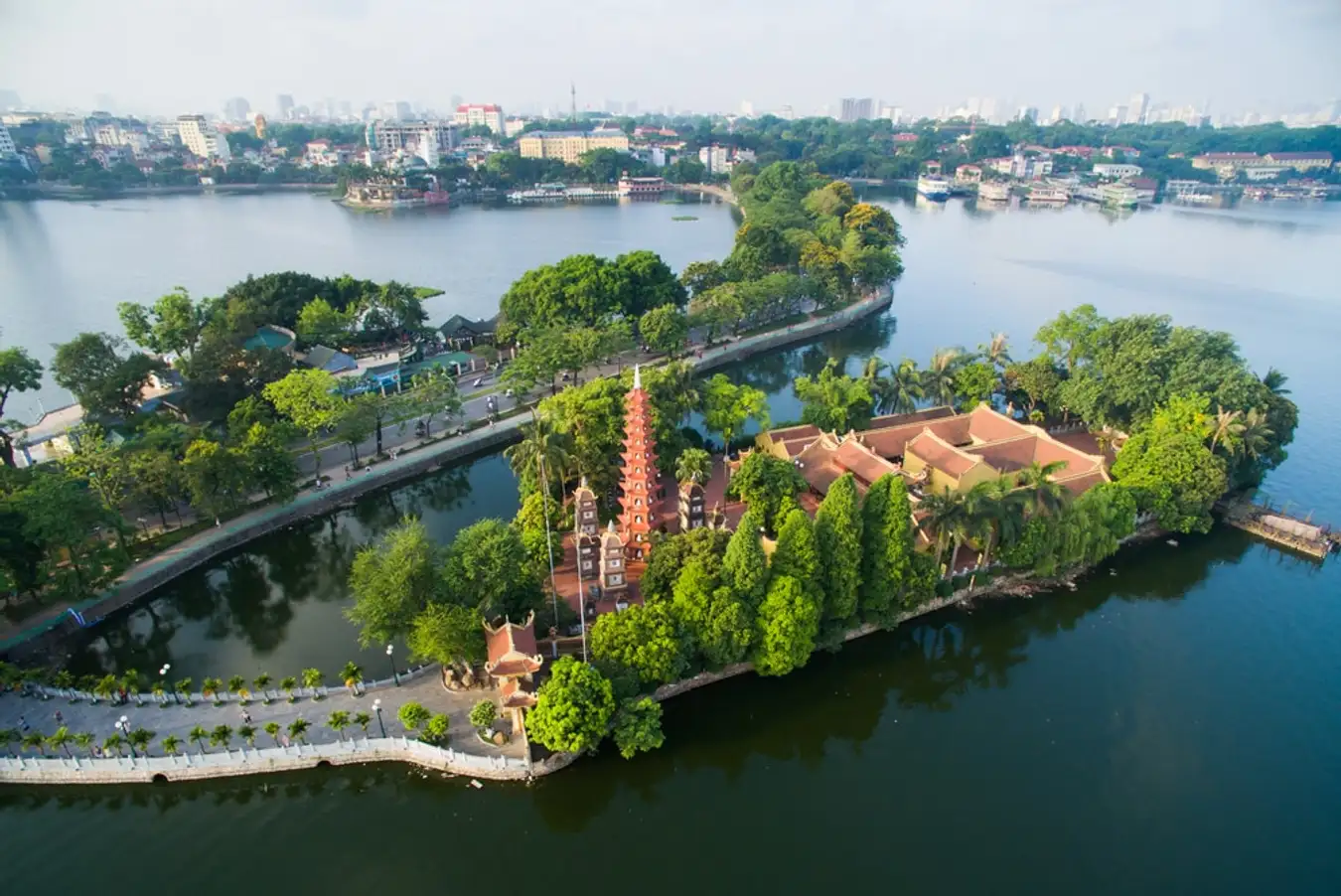
Where is the Tran Quoc pagoda?
Tran Quoc Pagoda is located on a small island in West Lake, Hanoi. The address is 46 Thanh Nien Street, Truc Bach, Tay Ho District, Hanoi. You can see it on Google Maps.
There are some ways to get from Hanoi Old Quarter to Tran Quoc Pagoda:
- By Bus: This is the most budget-friendly option, taking about 35 minutes to cover 3.3 km. You can see the directions on Google map. The bus route to get from Hanoi Old Quarter to Tran Quoc Pagoda is: Start at P. Hàng Ngang, Hàng Đào, Hoàn Kiếm, Hà Nội 100000, Vietnam. Take the bus to 46 Đ. Thanh Niên, Trúc Bạch, Tây Hồ, Hà Nội, Vietnam.
- Grab or Taxi: These are convenient options, taking about 13 minutes to cover 3.5 km. You can catch a Grab or taxi on most streets in Hanoi Old Quarter.
- By cyclo: This is a traditional Vietnamese way to get around, but it is not as efficient as other options. You can find cyclo drivers near Hoan Kiem Lake. However, I am currently unable to find directions for cyclo. You can see Hanoi streets and street vendors and some famous destinations by cyclo.
- By bike: This is a healthy and eco-friendly option, but it can be challenging due to traffic. The distance is about 5 km, so it should take around 30 minutes to bike.
Opening hours
The pagoda is open from 7:30 AM to 5:30 PM every day. However, there is a break from 11:30 AM to 1:30 PM for lunch.
Entrance fee
There is NO entrance fee to visit the pagoda. However, donations are welcome.
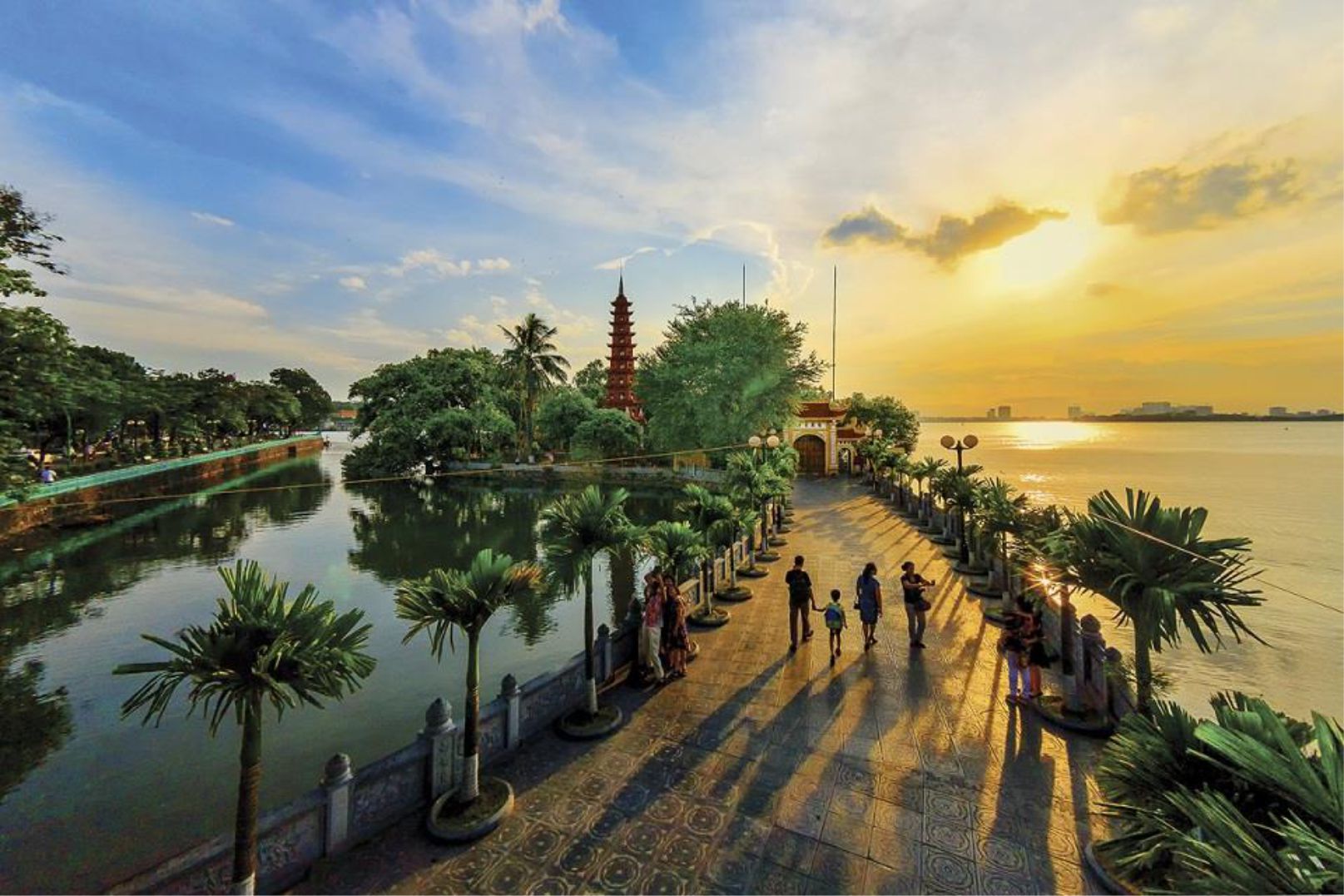
History of Tran Quoc pagoda
Tran Quoc Pagoda, a jewel nestled on a West Lake island, boasts a history as deep as Hanoi’s own. Born in the 6th century as Khai Quoc Pagoda, meaning “National Founder,” it stood proudly on the Red River’s banks. Imagine a serene temple amidst rice paddies, a witness to the nascent Thang Long city’s rise.
But time, like the ever-flowing river, brought change. Erosion threatened the pagoda’s foundation, leading to a monumental move in the 17th century. Tran Quoc, as it was then renamed, found a new haven on Kim Ngu Island, embracing the tranquil embrace of West Lake.
This relocation symbolized more than just a change of scenery. Tran Quoc, meaning “Protecting the Nation,” embodied the city’s hopes for peace and stability. Its architecture, a harmonious blend of Vietnamese and Buddhist styles, reflected this aspiration. Curved roofs, reminiscent of dragon scales, soared towards the sky, while lotus flower motifs hinted at spiritual purity.
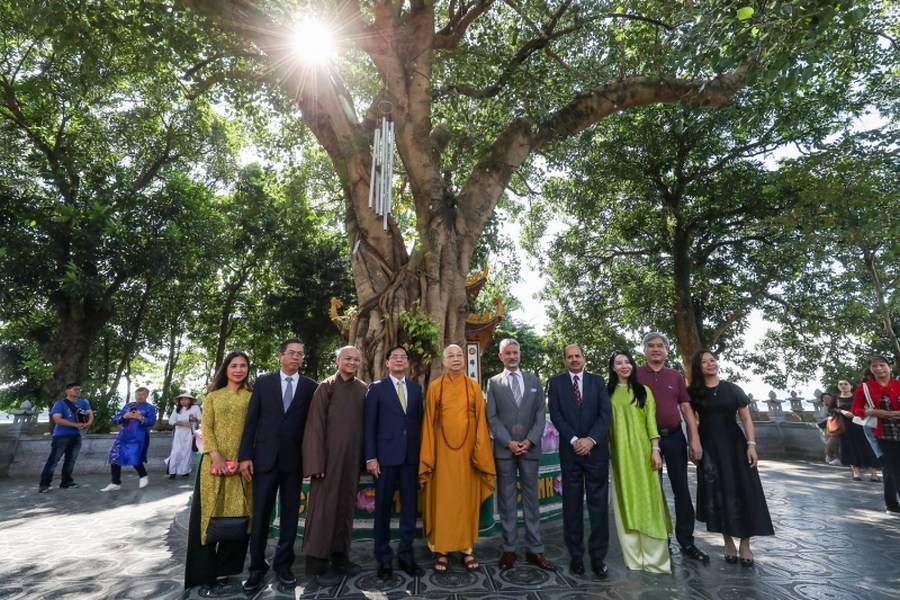
Stepping onto the pagoda’s grounds is like stepping back in time. The air hums with centuries of prayers and whispers of history. An eleven-story stupa, adorned with intricate carvings, pierces the skyline, offering panoramic views of the shimmering lake. Its presence speaks of resilience, a testament to the pagoda’s journey through time.
But amidst the grandeur, there’s serenity. A Bodhi tree, a sapling from the very tree under which the Buddha attained enlightenment, whispers wisdom under the gentle breeze. Its delicate leaves, reaching for the sun, symbolize the constant pursuit of spiritual growth.
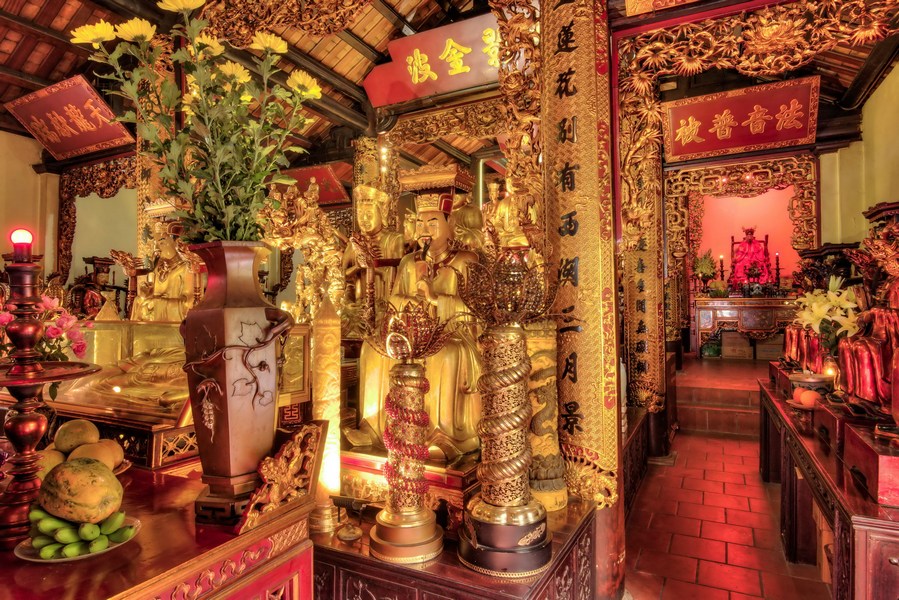
Tran Quoc Pagoda is more than just bricks and mortar. It’s a living embodiment of Hanoi’s soul, a tapestry woven with faith, resilience, and artistic expression. Whether you seek spiritual solace or historical intrigue, this island haven promises a journey into the heart of Hanoi’s vibrant past and peaceful present. So, close your eyes, inhale the scent of incense, and let Tran Quoc Pagoda transport you to a world where time whispers its secrets and serenity reigns supreme.
Structure of Tran Quoc pagoda
The intricate structure of Tran Quoc Pagoda is a mesmerizing blend of traditional Vietnamese and Buddhist architecture, each element speaking volumes about its history and spiritual significance. Here’s a closer look:
- Main Hall: The heart of the pagoda, the main hall boasts a curved tile roof adorned with intricate dragon scales, symbolizing power and protection. Inside, a colossal statue of the Buddha bathed in golden light radiates serenity and compassion.
- Three Houses: Following the auspicious number three in Vietnamese culture, the pagoda complex comprises three main houses arranged along a central axis. The front house welcomes visitors with ornate gates and guardian statues. The middle house, dedicated to prayer and offerings, features beautiful altars and intricate frescoes. The rear house, the most sacred space, houses the revered statue of the Shakyamuni Buddha.
- Eleven-Story Stupa: Rising majestically above the complex, the stupa, or Bao Thap, is a masterpiece of craftsmanship. Its eleven stories, adorned with arched windows and delicate lotus motifs, represent the path to enlightenment. Inside, each floor shelters a white gemstone statue of the Amitabha Buddha, symbolizing purity and hope.
- Bodhi Tree: A sapling from the sacred Bodhi tree in India, where the Buddha attained enlightenment, adds a touch of spiritual tranquility to the grounds. Its presence signifies the importance of seeking wisdom and finding inner peace.
- Other Elements: Intricate carvings, lotus ponds, serene courtyards, and traditional gongs enrich the pagoda’s structure, each detail contributing to its harmonious aura and inviting a sense of introspection.
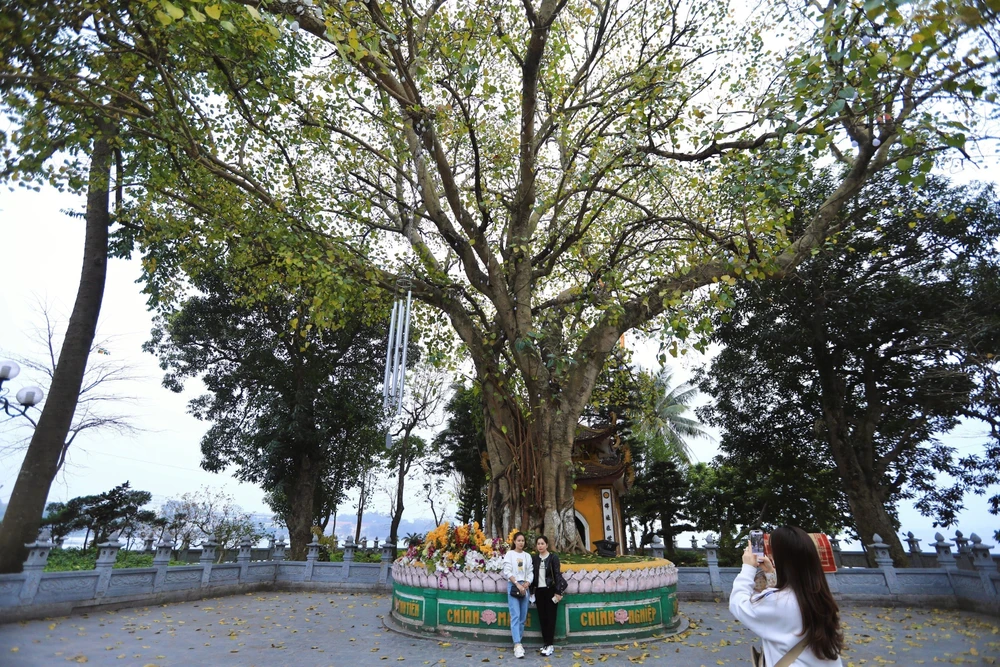
Tran Quoc Pagoda’s architecture speaks volumes about its history, beliefs, and cultural significance. From the protective dragons to the enlightened Bodhi tree, each element adds another layer to this majestic masterpiece, making it a must-visit for anyone seeking a glimpse into the heart of Hanoi’s spiritual heritage.
One of the most special features of Tran Quoc Pagoda is its location on a small island in West Lake. This gives the pagoda a peaceful and serene atmosphere. Another special feature is the 11-story stupa, which is one of the tallest pagodas in Vietnam.
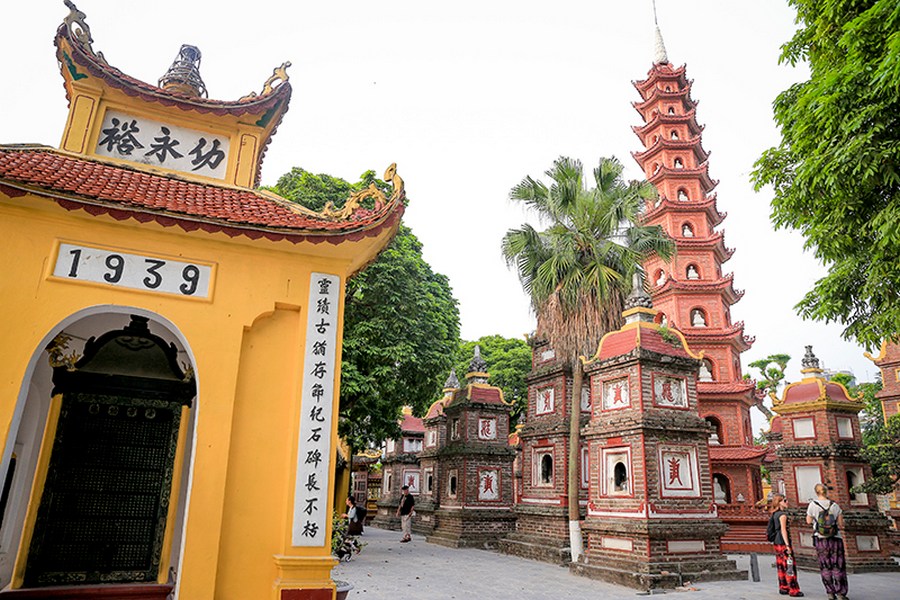
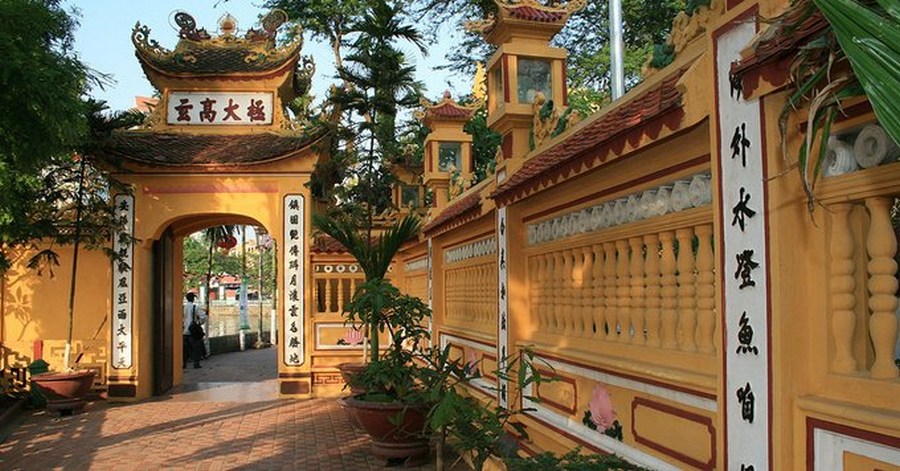

Who is worshiped at Tran Quoc Pagoda?
Tran Quoc Pagoda primarily focuses on worshipping figures and concepts within the Mahayana branch of Buddhism. Here’s who you’ll find:
Main Buddhas:
- Amitabha Buddha: The central statue in the main hall, radiating compassion and representing the Pure Land, where believers seek rebirth.
- Shakyamuni Buddha: Revered as the founder of Buddhism, often depicted in a reclining or seated posture in the rear house.
Other Important Figures:
- Avalokitesvara Bodhisattva: The embodiment of compassion and mercy, sometimes seen with multiple arms and faces representing their ability to help all beings.
- Guan Yu: A revered Chinese historical figure and military hero, traditionally worshipped for his loyalty, integrity, and martial prowess.
- Guan Ping and Zhou Shang: Loyal companions of Guan Yu, also venerated for their martial skills and unwavering support.
Additional Worshipped Elements:
- Anathapindika: A wealthy patron of the Buddha, honored for his generosity and support of the Buddhist community.
- Mẫu (Mothers): These goddesses, worshipped in Vietnamese folk religion, represent different aspects of nature and protect families. Their altars are found near the pagoda entrance.
Tran Quoc Pagoda is a place of inclusivity and welcomes people of all beliefs and backgrounds. While Buddhist figures are central to worship, visitors are free to pay respects and offer prayers to any deities or concepts that resonate with them. So, whether you’re a devout Buddhist, a curious explorer, or simply seeking a moment of peace, Tran Quoc Pagoda offers a sanctuary where you can connect with spirituality, history, and the essence of Hanoi.

Some tips when you travel Tran Quoc pagoda
The best time to visit Tran Quoc Pagoda is early in the morning or late in the afternoon, when the light is soft, and the crowds are smaller.
Be sure to dress modestly, and remove your shoes before entering the main hall of the pagoda.
Famous Tourist Destinations near Tran Quoc Pagoda
Embark on a fulfilling exploration of Hanoi’s cultural treasures by starting at Tran Quoc Pagoda and venturing into its nearby attractions:
- Thang Long Imperial Citadel: Step into the pages of history at the Thang Long Imperial Citadel, an enchanting heritage site closely tied to the evolution of ancient Thang Long. As a pivotal figure in Vietnam’s historical relics system, the citadel invites exploration of its significant structures, including the iconic Đoan Môn (Main Gate), Bắc Môn (North Gate), Điện Kính Thiên (Kinh Thien Palace), and an intriguing archaeological site.
- Ho Chi Minh Mausoleum: A visit to the Ho Chi Minh Mausoleum is a poignant experience, honoring the final resting place of the beloved national leader. Surrounded by serene bamboo groves, the mausoleum provides a tranquil atmosphere. Open on select mornings, visitors have the opportunity to witness flag ceremonies, with a gentle reminder to dress modestly and avoid electronic recording devices.
- Hanoi Old Quarter: Dive into the vibrant atmosphere of the Hanoi Old Quarter, situated around the northern and western parts of Hoan Kiem Lake. Each street is a unique marketplace, offering a variety of goods. Explore the charm of ancient houses, capture memorable moments through photography, and indulge in local culinary delights such as Cha Ca La Vong (grilled fish), Bun Rieu Cua (crab noodle soup), and Pho Bat Dan (noodle soup).
- Tay Ho Palace: Discover the spiritual allure of Tay Ho Palace, also known as the Liễu Hạnh Princess Temple. Its unique architectural details, reflecting Vietnamese culture, make it a popular destination for those seeking scenic views, photography opportunities, and blessings of health, fortune, and success.
Hoa Lo prison – Maison Centrale Located in the downtown of Hanoi, between Hanoi Old Quarter and Hanoi French Quarter, Hoa Lo prison was built by the French administration in 1896. This prison was used to hold political prisoners during colonial times and later to hold the US pilot in the Vietnam War by the Democratic Republic of Vietnam. Visit Hoa Lo prison, you can get both understanding of the French colonial era and the Vietnam War.
Amidst the ebb and flow of Hanoi’s history, Tran Quoc Pagoda remains a resilient symbol of cultural heritage. Serving as a hub for essential Buddhist activities, it is revered by locals as the “Sacred Pagoda in Hanoi.”
